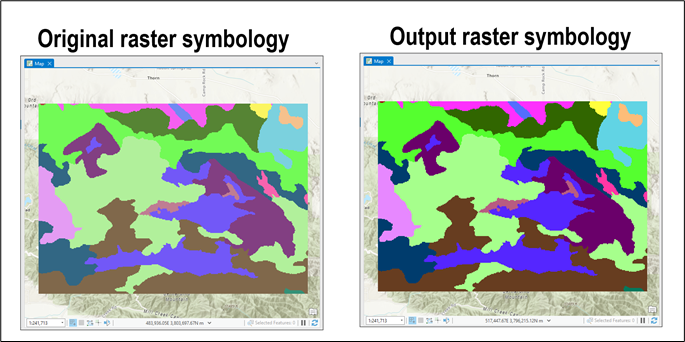HOW TO
Preserve symbology when exporting raster data in ArcGIS Pro
Summary
In ArcGIS Pro, raster data can be exported or converted to another format using the Export Raster pane or the Copy Raster geoprocessing tool. By default, converting or exporting raster data to another format does not retain the raster data’s symbology in the output layer. While checking the Use Renderer check box when exporting the raster data retains the symbology in the output layer, the output symbology may display a slight color difference from the original symbology or may result in a gray scale symbology. If the Use Renderer option does not retain the raster data’s symbology after exporting, apply the other alternatives provided in this article to preserve the symbology in the exported raster.
Procedure
Depending on the suitability, the workflows provided are applicable to preserve symbology when exporting raster data in ArcGIS Pro.
Check the Use Renderer and Force RBG or Use Colormap check boxes
When exporting the raster data, check the Use Renderer and Force RBG or Use Colormap check boxes to preserve its symbology in the exported layer.
- Open the ArcGIS Pro project.
- In the Contents pane, browse to and right-click the raster layer, and select Data > Export Raster to open the Export Raster pane.
- In the Export Raster pane, under Renderer Settings, check both the Use Renderer and Force RGB or Use Colormap check boxes. In this example, the Use Renderer and Use Colormap check boxes are checked.
- Click Export.
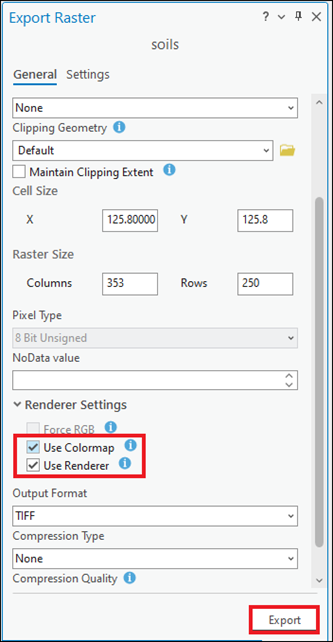
Note: The Use Renderer and Force RGB options exports the output as an RGB raster with three or four bands wherein the output raster may display a slight color difference from the original raster symbology.
Export the raster symbology as a raster function template
Export the raster symbology as a raster function template, create a new raster layer using it, and export the layer to the desired format.
- In ArcGIS Pro, save the raster symbology as a raster function template. Refer to ArcGIS Pro: Save symbology settings as a template for more information.
- Use the raster function template to create a new raster layer with the preferred raster symbology.
- On the top ribbon, on the Imagery tab, click Raster Functions in the Analysis group to open the Raster Functions pane.
- In the Raster Functions pane, on the Custom tab, expand the custom function category node, and click the raster function template created in Step 1. (In this example, the raster function template is Soils.) The <Raster function name> Properties pane opens.
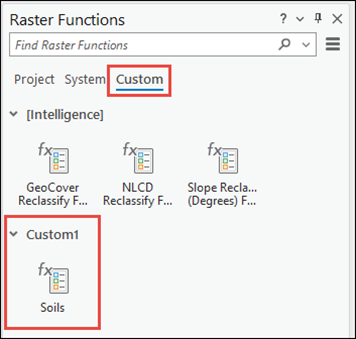
- In the <Raster function name> Properties pane, on the Parameters tab, select the raster layer under Raster. In this example, the raster layer named soils is selected.
- Click Create new layer. An RBG raster layer is added to the Contents pane.
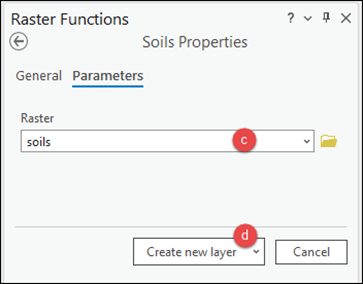
- In the Contents pane, export the RBG raster layer to the desired format. Refer to ArcGIS Pro: Export or convert raster datasets for more information.
Save the raster symbology as a layer file and apply it to the exported raster
- In ArcGIS Pro, save the raster symbology as a layer file.
- In the Contents pane, browse to and right-click the raster layer, and select Sharing > Save As Layer File.
- In the Save Layer File window, save the layer file in the preferred location.
- Click OK.
- Export the raster layer to the preferred format. Refer to ArcGIS Pro: Export or convert raster datasets for more information. The exported raster is automatically added to the Contents pane.
- Import the raster symbology layer file saved in Step 1 to the exported raster layer.
- In the Contents pane, browse to and right-click the exported raster layer, and select Symbology to open the Symbology pane.
- In the Symbology pane, click Options
 , and select Import from layer file.
, and select Import from layer file. - In the Import symbology window, browse to the location where the layer file is saved and click the file. Click OK.
Use the Apply Symbology From Layer tool to apply the raster symbology to the exported raster
- In ArcGIS Pro, export the raster layer to the preferred format. Refer to ArcGIS Pro: Export or convert raster datasets for more information. The exported raster is automatically added to the Contents pane.
- Run the Apply Symbology From Layer tool to apply the raster symbology to the exported raster layer.
- In the Contents pane, browse to and right-click the exported raster layer, and select Symbology to open the Symbology pane.
- In the Symbology pane, click Options
 , and select Import from layer. The Apply Symbology From Layer geoprocessing tool opens.
, and select Import from layer. The Apply Symbology From Layer geoprocessing tool opens. - In the Apply Symbology From Layer pane, on the Parameters tab, ensure the exported raster layer is selected for Input Layer. In this example, Exported_soils is selected.
- Select the raster layer to apply the desired symbology for Symbology Layer. In this example, soils is selected.
- Leave the other parameters as default.
- Click Run.
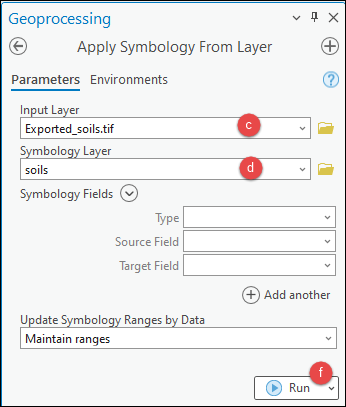
Note: If exporting raster data to other formats is not mandatory, consider saving the raster data as a layer package. A layer package saves the layer details, including its symbology, labeling, field properties, and associated data, whereby users can add the layer package directly to their maps without the need to set the layer properties. Refer to ArcGIS Pro: Share a layer package for more information.
Article ID: 000028218
- ArcGIS Pro 3 0
- ArcGIS Pro 2 8 x
- ArcGIS Pro 2 x
Get help from ArcGIS experts
Start chatting now
